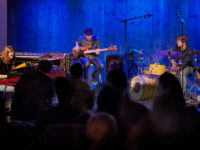A lot of best and most successful jazz artists come from the best music programs: Berklee, Manhattan School of Music, and Julliard, have all produced countless musicians who’ve gone on to make big impacts on jazz. But when talking about fertile breeding grounds for jazz greats, the University of North Texas has to be in the conversation, too. Prominent UNT alumni include Jimmy Giuffre, Lyle Mays and Norah Jones. Brad Leali is currently on the faculty there. There’s no telling how many recent grads and professors are about to make an impact far beyond the Denton, Texas campus, but I can certainly offer up a name who should.
Her name is Kait Dunton.
Dunton got her Masters of Music in Jazz Studies at UNT, as well as taught there. She’s run the gamut of leading a ten-piece contemporary electric ensemble to teaching a Jazz Piano fundamentals class, to performing with big bands, Latin bands and fusion bands. She’s also attended an international music residency on jazz and creative music led by Dave Douglas. She’s also no stranger to the art of creating new arrangements for old jazz standards. It was during these experiences when Dunton had honed her compositional skills until she had built up a collection of songs large enough and strong enough to merit her first solo record.
She’s back at her native California, now, but before her return there, she indeed recorded an album of eight of her originals in a traditional piano trio setting with Daniel Foose on acoustic bass and Ross Pederson on drums. A conventional, tried and true setting, yes. Boring, rote music, no. Not even close.
On this album she christened Real & Imagined, Dunton’s compositions are consistently well-developed and hard to get out of your mind once you let them sink in. That’s saying a lot, because these pieces don’t ever take the path of least resistance; there’s tempo changes, musical trains of thoughts stopping on a dime and changing to other (albeit related) thoughts, and other delightful, unexpected twists and turns. Perhaps what makes this so listenable, though, is that Dunton’s music is like that popular breakfast cereal: it’s got a lot of snap, crackle and pop. That goes the same for the performances as well. The enthusiasm for tackling these challenging arrangements shines through on every single track.
That eager spirit greets listeners from the opening notes of “Machine 2.” It’s a light, dancing number that required much agility from the players, with a time signature so mysterious, not even the band members can agree on what it is. “Train Of Thought” starts in 3/4 time then moves into a swing tempo and back to the waltz as Dunton produces a bouncing, authoritative solo.
If there’s a key track on this album, it would have to be “Phase/Faze” (see Mark Saleski’s enthusiastic review of that cut here). This is really two songs, or distinct moods, meshed elegantly into a single composition. The opening volley of chords propelled by Pederson’s drums is a very effective way of telling the listener to “sit up and pay attention” and delivers on the promise of an exciting aural journey. It swerves and swells before settling down just enough to provide a plateau for Dunton’s brisk right-hand excursions. About four minutes in, the song is slowed down and a new chord progression is introduced, taking the song to a perfectly executed, three point landing.
“Backstage” is a 5/4 number that disguises itself as a 3/4 waltz. It has a melody so fetching and hard to shake, it’s destined to become cover material. Listen to how Pederson’s crisp hi-hat and rim work elevate both Dunton’s and Feese’s solos without calling undue attention to himself, something he does so well all over this album.
Those first four tracks are breathtakingly outstanding, but Ms. Dunton isn’t done yet. The title cut “Real & Imagined” shows off Dunton’s ability for constructing thoughtful, evolving ballads, using an ostinato that builds from a crawl to a full out sprint, her considerable chops reaching full bloom right at the point where that ostinato mutates, and then moves on to another one. At that moment Dunton simultaneously switches from lead to comp role as Peterson takes over, as he proceeds to lay waste to his kit.
“Machine,” no relation to “Machine 2,” is a series of divergent but related parts. Foose provides a solid pulse for Dunton to improvise over in the key middle section, followed by a fleet-fingered upper register solo of his own. The record closes with two relatively brief, low key numbers, the somber, Bill Evans-like “Home” and “Epilogue,” which has a melodic line easily intriguing and intelligent enough to have been made into a full-length song.
Once in a long while you come across music that has the unique quality of being something that is so substantial and yet can be so naturally fun to listen to. Kait Dunton’s first effort Real & Imagined is such a record. She also throws cold water on any notion that the piano/bass/drums format is an exhausted one. It’s very much alive and well, and here is all the proof you need.
Let me put it more bluntly: buy this record.
Now.
- Matthew Shipp – ‘The Cosmic Piano’ (2025) - June 17, 2025
- Ivo Perelman & Matthew Shipp String Trio – ‘Armageddon Flower’ (2025) - June 16, 2025
- Claudio Scolari Project – ‘Bloom’ (2025) - June 12, 2025




